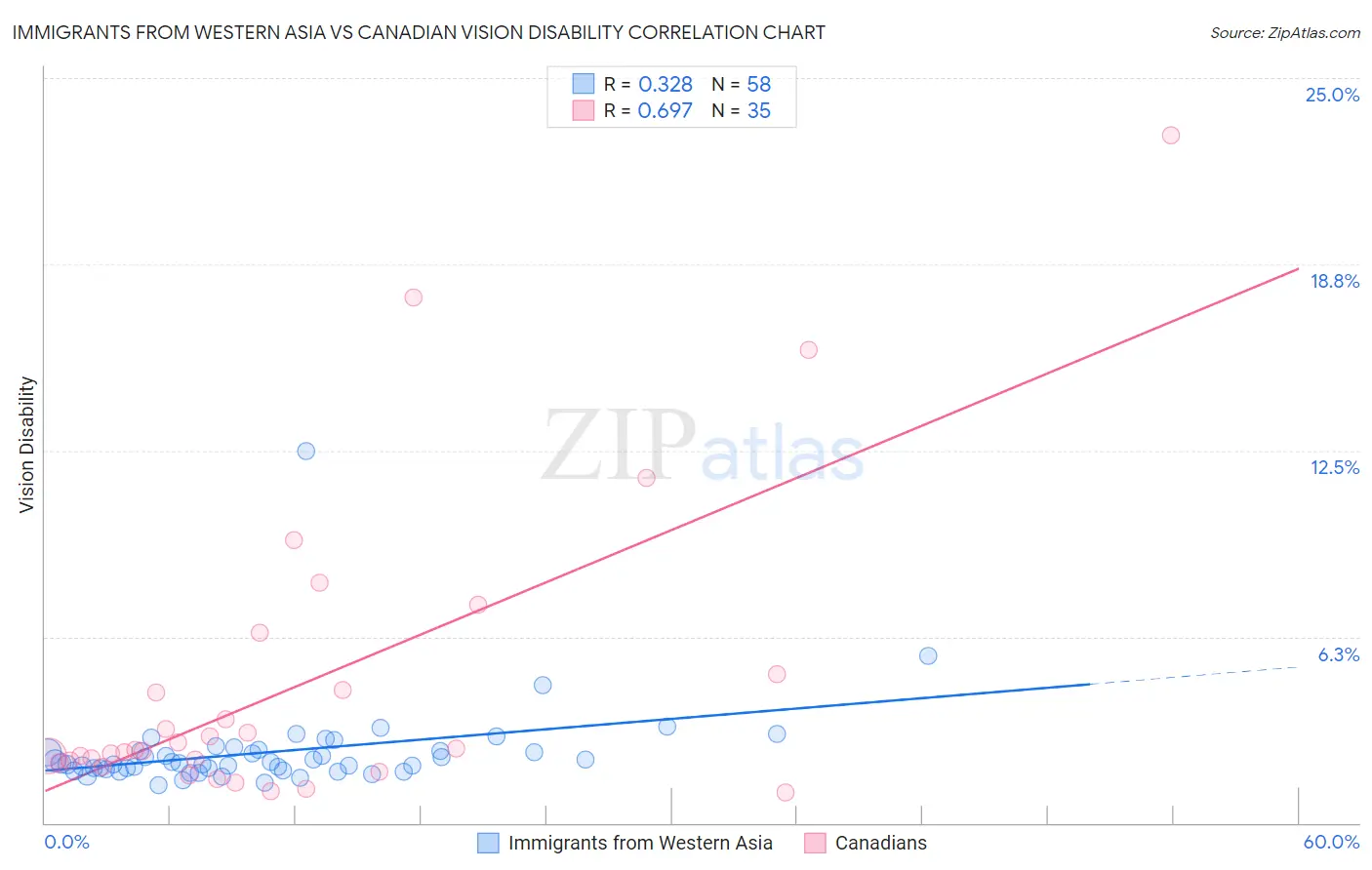Immigrants from Western Asia vs Canadian Vision Disability
COMPARE
Immigrants from Western Asia
Canadian
Vision Disability
Vision Disability Comparison
Immigrants from Western Asia
Canadians
2.0%
VISION DISABILITY
97.5/ 100
METRIC RATING
83rd/ 347
METRIC RANK
2.2%
VISION DISABILITY
25.8/ 100
METRIC RATING
191st/ 347
METRIC RANK
Immigrants from Western Asia vs Canadian Vision Disability Correlation Chart
The statistical analysis conducted on geographies consisting of 404,140,331 people shows a mild positive correlation between the proportion of Immigrants from Western Asia and percentage of population with vision disability in the United States with a correlation coefficient (R) of 0.328 and weighted average of 2.0%. Similarly, the statistical analysis conducted on geographies consisting of 437,069,200 people shows a significant positive correlation between the proportion of Canadians and percentage of population with vision disability in the United States with a correlation coefficient (R) of 0.697 and weighted average of 2.2%, a difference of 7.9%.

Vision Disability Correlation Summary
| Measurement | Immigrants from Western Asia | Canadian |
| Minimum | 1.3% | 1.0% |
| Maximum | 12.5% | 23.1% |
| Range | 11.2% | 22.0% |
| Mean | 2.4% | 4.7% |
| Median | 2.0% | 2.4% |
| Interquartile 25% (IQ1) | 1.8% | 2.0% |
| Interquartile 75% (IQ3) | 2.4% | 5.0% |
| Interquartile Range (IQR) | 0.59% | 3.0% |
| Standard Deviation (Sample) | 1.5% | 5.1% |
| Standard Deviation (Population) | 1.5% | 5.0% |
Similar Demographics by Vision Disability
Demographics Similar to Immigrants from Western Asia by Vision Disability
In terms of vision disability, the demographic groups most similar to Immigrants from Western Asia are Immigrants from Poland (2.0%, a difference of 0.080%), Soviet Union (2.0%, a difference of 0.11%), Immigrants from Latvia (2.0%, a difference of 0.12%), Lithuanian (2.0%, a difference of 0.17%), and Chinese (2.0%, a difference of 0.17%).
| Demographics | Rating | Rank | Vision Disability |
| Paraguayans | 98.3 /100 | #76 | Exceptional 2.0% |
| Immigrants | Jordan | 98.3 /100 | #77 | Exceptional 2.0% |
| Immigrants | Eastern Europe | 98.3 /100 | #78 | Exceptional 2.0% |
| Assyrians/Chaldeans/Syriacs | 98.1 /100 | #79 | Exceptional 2.0% |
| Lithuanians | 97.7 /100 | #80 | Exceptional 2.0% |
| Soviet Union | 97.6 /100 | #81 | Exceptional 2.0% |
| Immigrants | Poland | 97.6 /100 | #82 | Exceptional 2.0% |
| Immigrants | Western Asia | 97.5 /100 | #83 | Exceptional 2.0% |
| Immigrants | Latvia | 97.3 /100 | #84 | Exceptional 2.0% |
| Chinese | 97.2 /100 | #85 | Exceptional 2.0% |
| Immigrants | Moldova | 97.2 /100 | #86 | Exceptional 2.0% |
| Immigrants | Switzerland | 97.0 /100 | #87 | Exceptional 2.0% |
| Norwegians | 97.0 /100 | #88 | Exceptional 2.0% |
| Immigrants | Eastern Africa | 97.0 /100 | #89 | Exceptional 2.0% |
| Immigrants | Lebanon | 96.7 /100 | #90 | Exceptional 2.1% |
Demographics Similar to Canadians by Vision Disability
In terms of vision disability, the demographic groups most similar to Canadians are European (2.2%, a difference of 0.010%), Immigrants from Costa Rica (2.2%, a difference of 0.020%), British (2.2%, a difference of 0.060%), Salvadoran (2.2%, a difference of 0.13%), and Immigrants from Barbados (2.2%, a difference of 0.15%).
| Demographics | Rating | Rank | Vision Disability |
| Moroccans | 35.4 /100 | #184 | Fair 2.2% |
| Immigrants | Middle Africa | 33.5 /100 | #185 | Fair 2.2% |
| Native Hawaiians | 33.3 /100 | #186 | Fair 2.2% |
| Immigrants | St. Vincent and the Grenadines | 30.3 /100 | #187 | Fair 2.2% |
| Guyanese | 28.9 /100 | #188 | Fair 2.2% |
| Salvadorans | 27.4 /100 | #189 | Fair 2.2% |
| Immigrants | Costa Rica | 26.1 /100 | #190 | Fair 2.2% |
| Canadians | 25.8 /100 | #191 | Fair 2.2% |
| Europeans | 25.7 /100 | #192 | Fair 2.2% |
| British | 25.1 /100 | #193 | Fair 2.2% |
| Immigrants | Barbados | 24.0 /100 | #194 | Fair 2.2% |
| Immigrants | Immigrants | 23.7 /100 | #195 | Fair 2.2% |
| Immigrants | Grenada | 23.1 /100 | #196 | Fair 2.2% |
| Ghanaians | 21.8 /100 | #197 | Fair 2.2% |
| Czechoslovakians | 21.6 /100 | #198 | Fair 2.2% |